FIAT 500E 2017 2.G Owner's Manual
Manufacturer: FIAT, Model Year: 2017, Model line: 500E, Model: FIAT 500E 2017 2.GPages: 300, PDF Size: 2.58 MB
Page 21 of 300
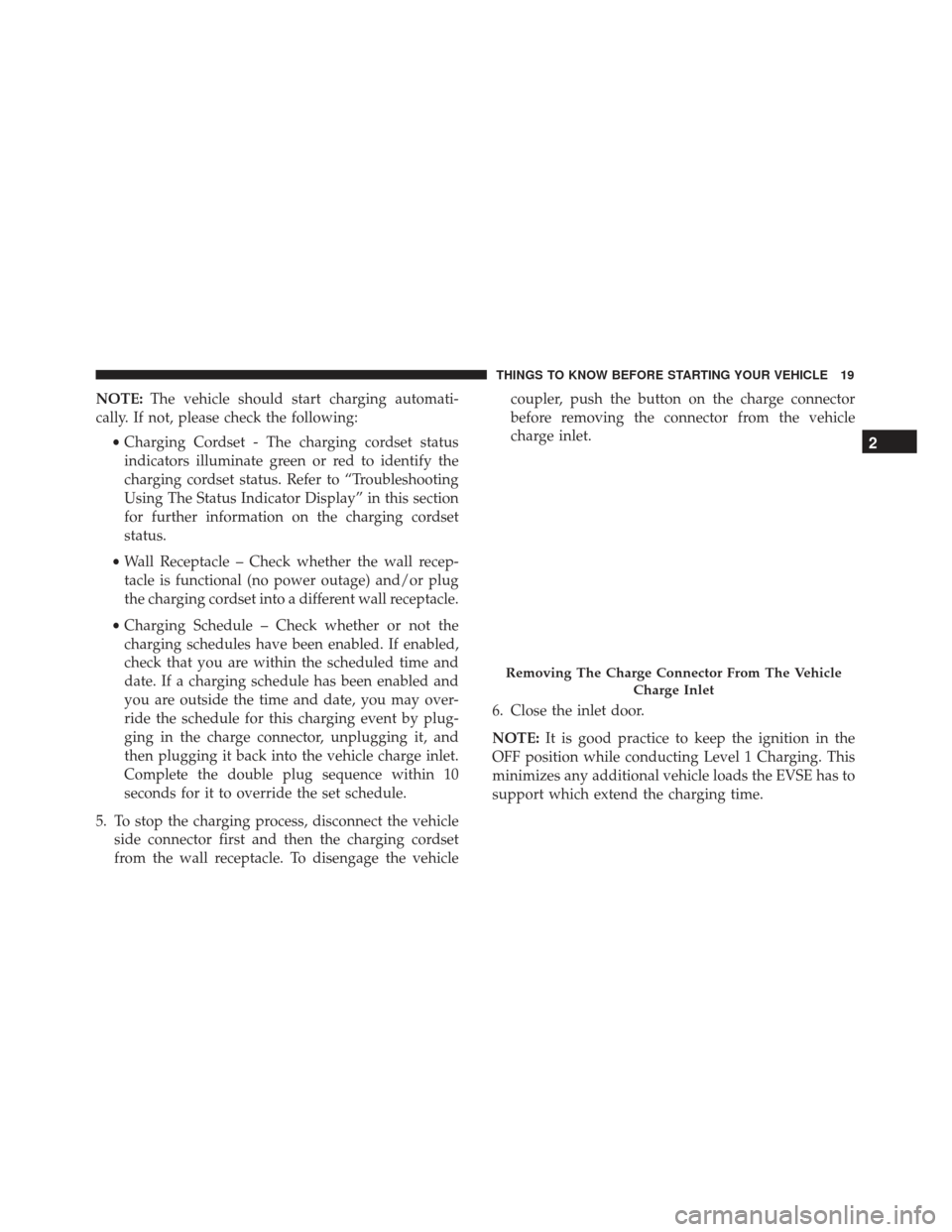
NOTE:The vehicle should start charging automati-
cally. If not, please check the following:
•Charging Cordset - The charging cordset status
indicators illuminate green or red to identify the
charging cordset status. Refer to “Troubleshooting
Using The Status Indicator Display” in this section
for further information on the charging cordset
status.
• Wall Receptacle – Check whether the wall recep-
tacle is functional (no power outage) and/or plug
the charging cordset into a different wall receptacle.
• Charging Schedule – Check whether or not the
charging schedules have been enabled. If enabled,
check that you are within the scheduled time and
date. If a charging schedule has been enabled and
you are outside the time and date, you may over-
ride the schedule for this charging event by plug-
ging in the charge connector, unplugging it, and
then plugging it back into the vehicle charge inlet.
Complete the double plug sequence within 10
seconds for it to override the set schedule.
5. To stop the charging process, disconnect the vehicle side connector first and then the charging cordset
from the wall receptacle. To disengage the vehicle coupler, push the button on the charge connector
before removing the connector from the vehicle
charge inlet.
6. Close the inlet door.
NOTE: It is good practice to keep the ignition in the
OFF position while conducting Level 1 Charging. This
minimizes any additional vehicle loads the EVSE has to
support which extend the charging time.
Removing The Charge Connector From The Vehicle
Charge Inlet
2
THINGS TO KNOW BEFORE STARTING YOUR VEHICLE 19
Page 22 of 300
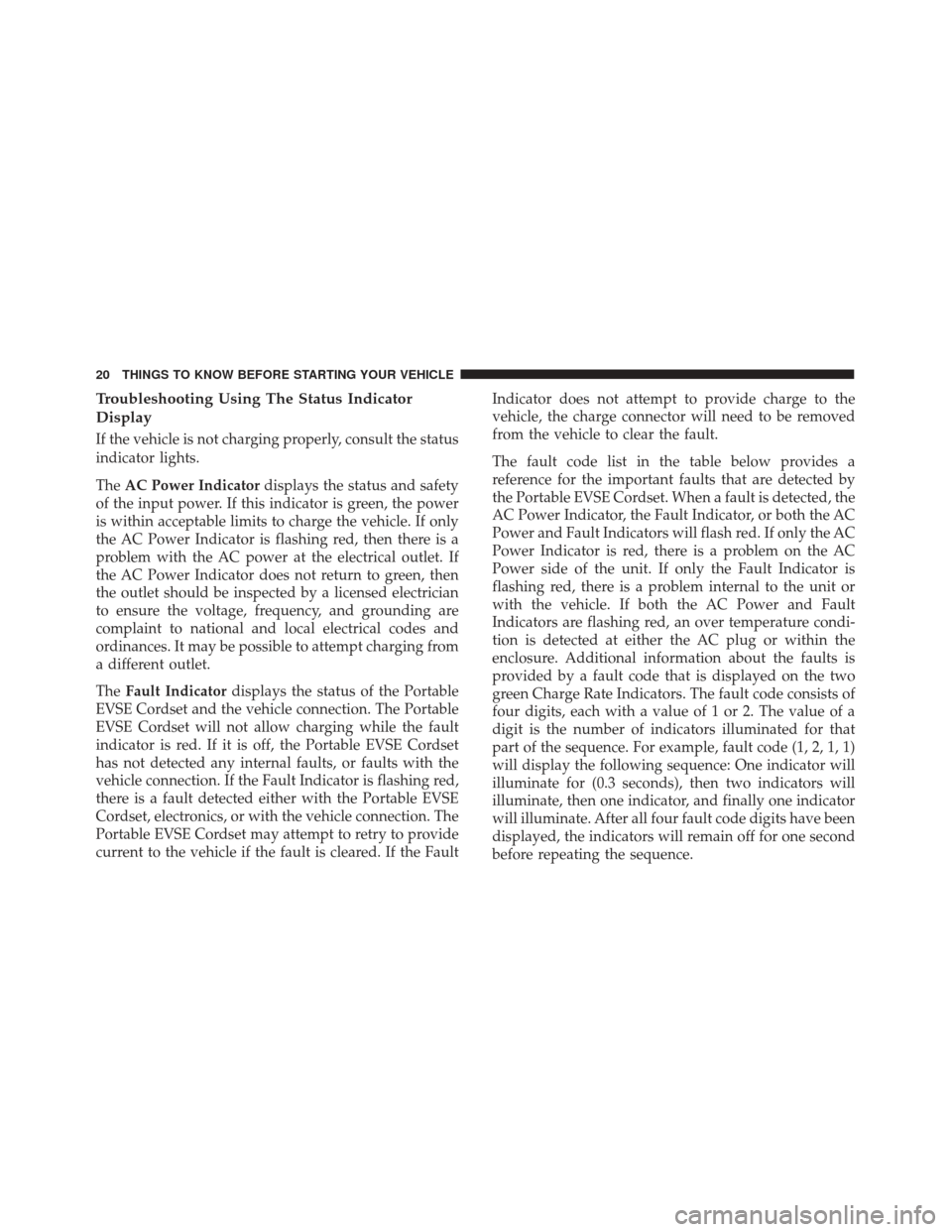
Troubleshooting Using The Status Indicator
Display
If the vehicle is not charging properly, consult the status
indicator lights.
TheAC Power Indicator displays the status and safety
of the input power. If this indicator is green, the power
is within acceptable limits to charge the vehicle. If only
the AC Power Indicator is flashing red, then there is a
problem with the AC power at the electrical outlet. If
the AC Power Indicator does not return to green, then
the outlet should be inspected by a licensed electrician
to ensure the voltage, frequency, and grounding are
complaint to national and local electrical codes and
ordinances. It may be possible to attempt charging from
a different outlet.
The Fault Indicator displays the status of the Portable
EVSE Cordset and the vehicle connection. The Portable
EVSE Cordset will not allow charging while the fault
indicator is red. If it is off, the Portable EVSE Cordset
has not detected any internal faults, or faults with the
vehicle connection. If the Fault Indicator is flashing red,
there is a fault detected either with the Portable EVSE
Cordset, electronics, or with the vehicle connection. The
Portable EVSE Cordset may attempt to retry to provide
current to the vehicle if the fault is cleared. If the Fault Indicator does not attempt to provide charge to the
vehicle, the charge connector will need to be removed
from the vehicle to clear the fault.
The fault code list in the table below provides a
reference for the important faults that are detected by
the Portable EVSE Cordset. When a fault is detected, the
AC Power Indicator, the Fault Indicator, or both the AC
Power and Fault Indicators will flash red. If only the AC
Power Indicator is red, there is a problem on the AC
Power side of the unit. If only the Fault Indicator is
flashing red, there is a problem internal to the unit or
with the vehicle. If both the AC Power and Fault
Indicators are flashing red, an over temperature condi-
tion is detected at either the AC plug or within the
enclosure. Additional information about the faults is
provided by a fault code that is displayed on the two
green Charge Rate Indicators. The fault code consists of
four digits, each with a value of 1 or 2. The value of a
digit is the number of indicators illuminated for that
part of the sequence. For example, fault code (1, 2, 1, 1)
will display the following sequence: One indicator will
illuminate for (0.3 seconds), then two indicators will
illuminate, then one indicator, and finally one indicator
will illuminate. After all four fault code digits have been
displayed, the indicators will remain off for one second
before repeating the sequence.
20 THINGS TO KNOW BEFORE STARTING YOUR VEHICLE
Page 23 of 300
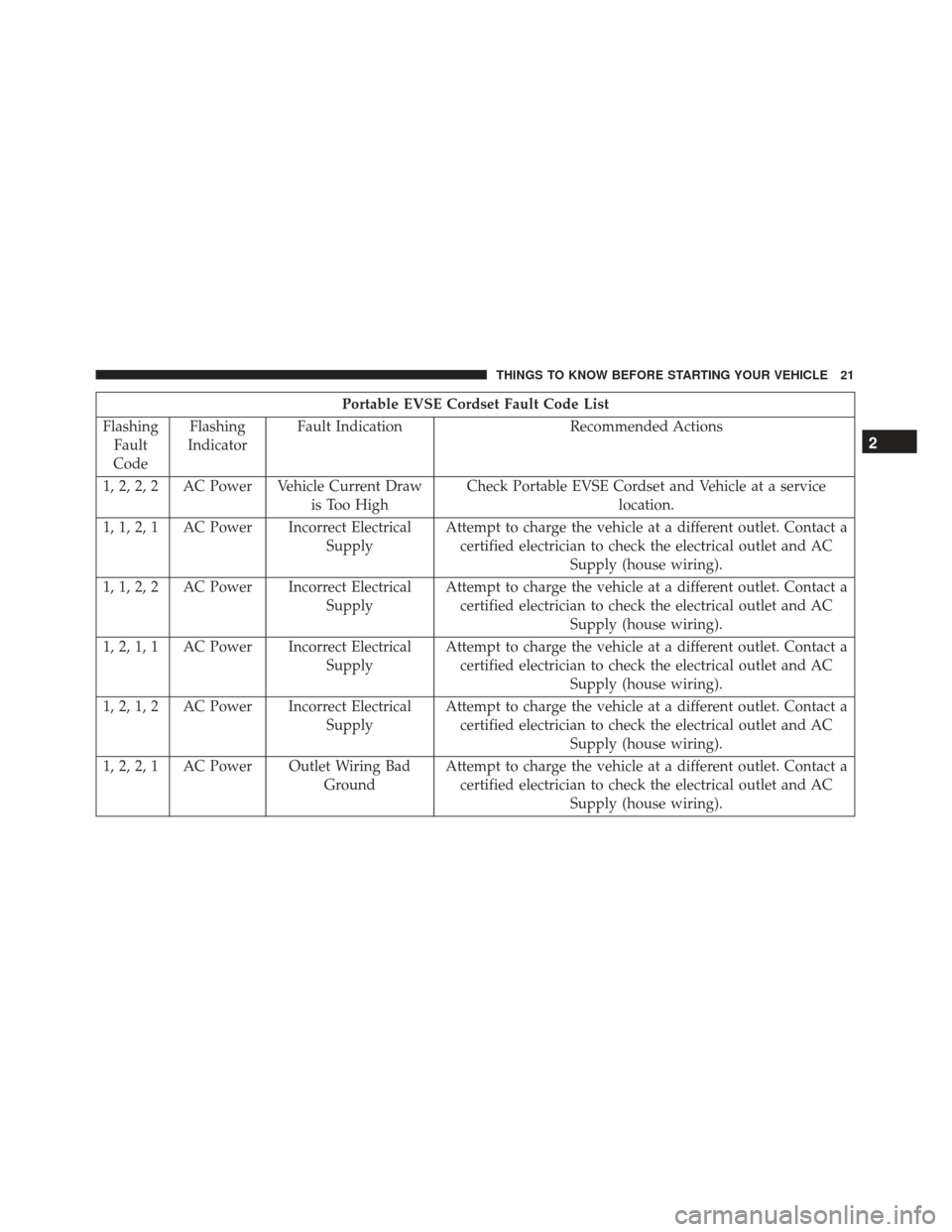
Portable EVSE Cordset Fault Code List
Flashing Fault
Code Flashing
Indicator Fault Indication
Recommended Actions
1, 2, 2, 2 AC Power Vehicle Current Draw is Too HighCheck Portable EVSE Cordset and Vehicle at a service
location.
1, 1, 2, 1 AC Power Incorrect Electrical SupplyAttempt to charge the vehicle at a different outlet. Contact a
certified electrician to check the electrical outlet and AC Supply (house wiring).
1, 1, 2, 2 AC Power Incorrect Electrical SupplyAttempt to charge the vehicle at a different outlet. Contact a
certified electrician to check the electrical outlet and AC Supply (house wiring).
1, 2, 1, 1 AC Power Incorrect Electrical SupplyAttempt to charge the vehicle at a different outlet. Contact a
certified electrician to check the electrical outlet and AC Supply (house wiring).
1, 2, 1, 2 AC Power Incorrect Electrical SupplyAttempt to charge the vehicle at a different outlet. Contact a
certified electrician to check the electrical outlet and AC Supply (house wiring).
1, 2, 2, 1 AC Power Outlet Wiring Bad GroundAttempt to charge the vehicle at a different outlet. Contact a
certified electrician to check the electrical outlet and AC Supply (house wiring).
2
THINGS TO KNOW BEFORE STARTING YOUR VEHICLE 21
Page 24 of 300

Portable EVSE Cordset Fault Code List
1, 1, 1, 1 Fault Portable EVSE Cord- set Internal FaultUnplug the Portable EVSE Cordset from the vehicle charge
inlet and retry to charge. If the issue is not corrected, check
the Portable EVSE Cordset and Vehicle at a service location.
1, 1, 1, 2 Fault Portable EVSE Cord- set Internal FaultUnplug the Portable EVSE Cordset from the vehicle charge
inlet and retry to charge. If the issue is not corrected, check
the Portable EVSE Cordset and Vehicle at a service location.
1, 2, 1, 1 Fault Portable EVSE Cord- set Internal FaultCheck Portable EVSE Cordset and Vehicle at a service
location.
1, 2, 1, 2 Fault CCID Leakage Cur- rent DetectedDisconnect charge connector and retry charging. If problem
persists, check the Portable EVSE Cordset and Vehicle at a service location.
2, 2, 2, 1 Fault Vehicle Interface Con- nectorError with the Vehicle Charge Connector Interface — Check
for water or other contamination in the vehicle charge inlet or charge connector.
2, 2, 2, 2 Fault Vehicle Interface Con- nectorError with the Vehicle Charge Connector Interface — Check
for water or other contamination in the vehicle charge inlet or charge connector
1, 1, 2, 1 Fault & AC PowerEVSE Enclosure Inter-
nal Temperature is Too High Use caution as the Portable EVSE Cordset housing may be
hot. It is recommended to move the Portable EVSE Cordset out of direct sun exposure. Allow the unit to cool. If error persists, check the Portable EVSE Cordset at a service location.
22 THINGS TO KNOW BEFORE STARTING YOUR VEHICLE
Page 25 of 300
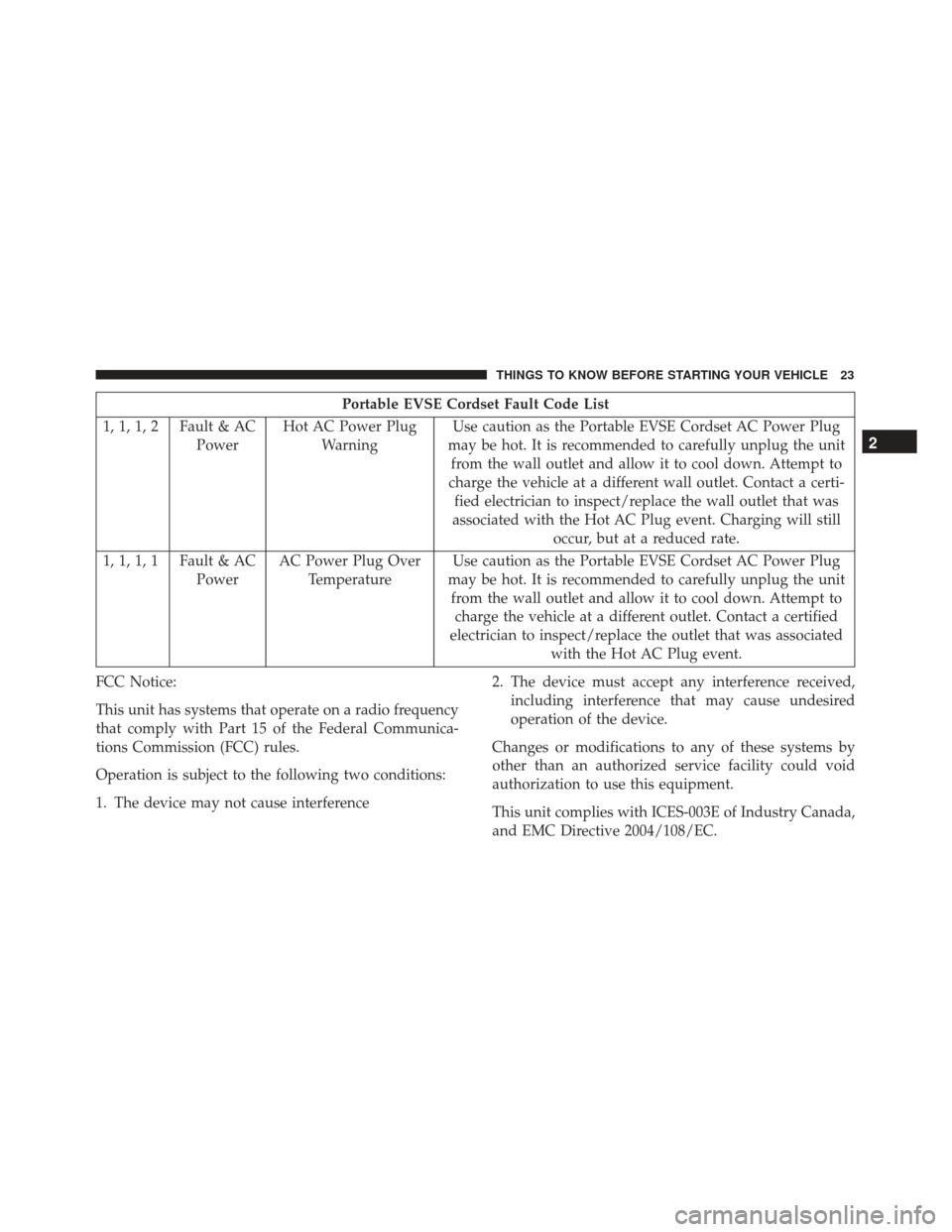
Portable EVSE Cordset Fault Code List
1, 1, 1, 2 Fault & AC PowerHot AC Power Plug
Warning Use caution as the Portable EVSE Cordset AC Power Plug
may be hot. It is recommended to carefully unplug the unit from the wall outlet and allow it to cool down. Attempt to
charge the vehicle at a different wall outlet. Contact a certi- fied electrician to inspect/replace the wall outlet that was
associated with the Hot AC Plug event. Charging will still occur, but at a reduced rate.
1, 1, 1, 1 Fault & AC PowerAC Power Plug Over
Temperature Use caution as the Portable EVSE Cordset AC Power Plug
may be hot. It is recommended to carefully unplug the unit from the wall outlet and allow it to cool down. Attempt to charge the vehicle at a different outlet. Contact a certified
electrician to inspect/replace the outlet that was associated with the Hot AC Plug event.
FCC Notice:
This unit has systems that operate on a radio frequency
that comply with Part 15 of the Federal Communica-
tions Commission (FCC) rules.
Operation is subject to the following two conditions:
1. The device may not cause interference 2. The device must accept any interference received,
including interference that may cause undesired
operation of the device.
Changes or modifications to any of these systems by
other than an authorized service facility could void
authorization to use this equipment.
This unit complies with ICES-003E of Industry Canada,
and EMC Directive 2004/108/EC.
2
THINGS TO KNOW BEFORE STARTING YOUR VEHICLE 23
Page 26 of 300
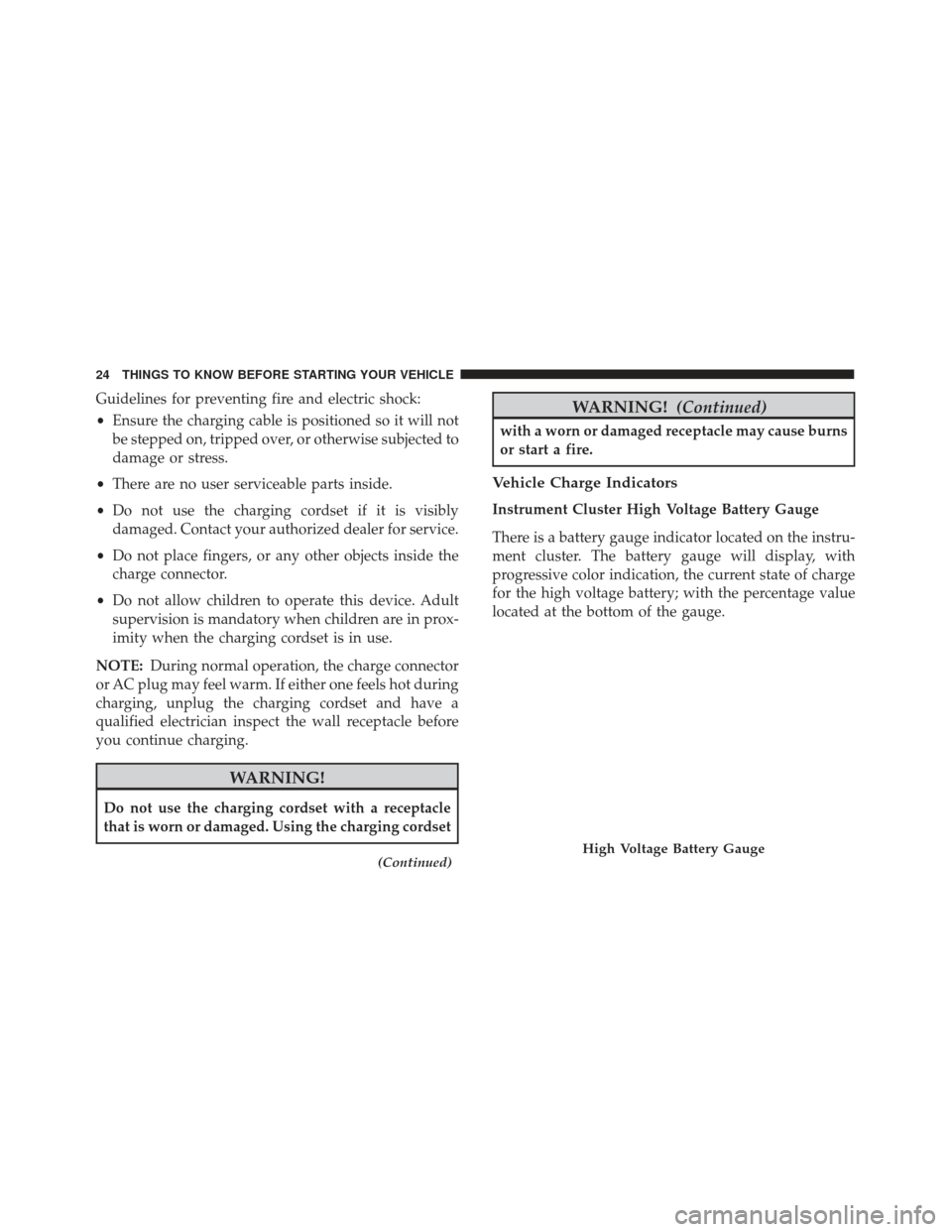
Guidelines for preventing fire and electric shock:
•Ensure the charging cable is positioned so it will not
be stepped on, tripped over, or otherwise subjected to
damage or stress.
• There are no user serviceable parts inside.
• Do not use the charging cordset if it is visibly
damaged. Contact your authorized dealer for service.
• Do not place fingers, or any other objects inside the
charge connector.
• Do not allow children to operate this device. Adult
supervision is mandatory when children are in prox-
imity when the charging cordset is in use.
NOTE: During normal operation, the charge connector
or AC plug may feel warm. If either one feels hot during
charging, unplug the charging cordset and have a
qualified electrician inspect the wall receptacle before
you continue charging.
WARNING!
Do not use the charging cordset with a receptacle
that is worn or damaged. Using the charging cordset
(Continued)
WARNING! (Continued)
with a worn or damaged receptacle may cause burns
or start a fire.
Vehicle Charge Indicators
Instrument Cluster High Voltage Battery Gauge
There is a battery gauge indicator located on the instru-
ment cluster. The battery gauge will display, with
progressive color indication, the current state of charge
for the high voltage battery; with the percentage value
located at the bottom of the gauge.
High Voltage Battery Gauge
24 THINGS TO KNOW BEFORE STARTING YOUR VEHICLE
Page 27 of 300
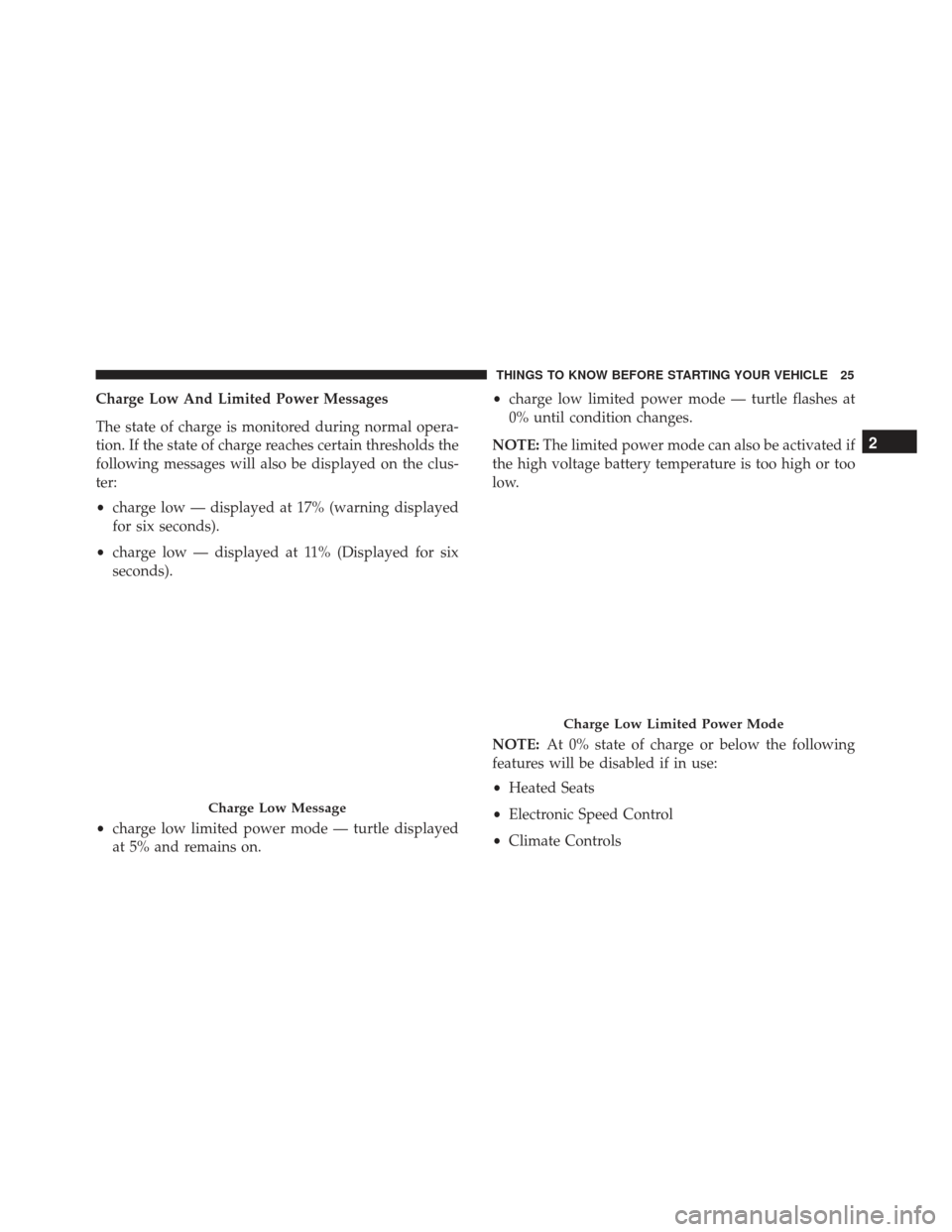
Charge Low And Limited Power Messages
The state of charge is monitored during normal opera-
tion. If the state of charge reaches certain thresholds the
following messages will also be displayed on the clus-
ter:
•charge low — displayed at 17% (warning displayed
for six seconds).
• charge low — displayed at 11% (Displayed for six
seconds).
• charge low limited power mode — turtle displayed
at 5% and remains on. •
charge low limited power mode — turtle flashes at
0% until condition changes.
NOTE: The limited power mode can also be activated if
the high voltage battery temperature is too high or too
low.
NOTE: At 0% state of charge or below the following
features will be disabled if in use:
• Heated Seats
• Electronic Speed Control
• Climate Controls
Charge Low Message
Charge Low Limited Power Mode
2
THINGS TO KNOW BEFORE STARTING YOUR VEHICLE 25
Page 28 of 300
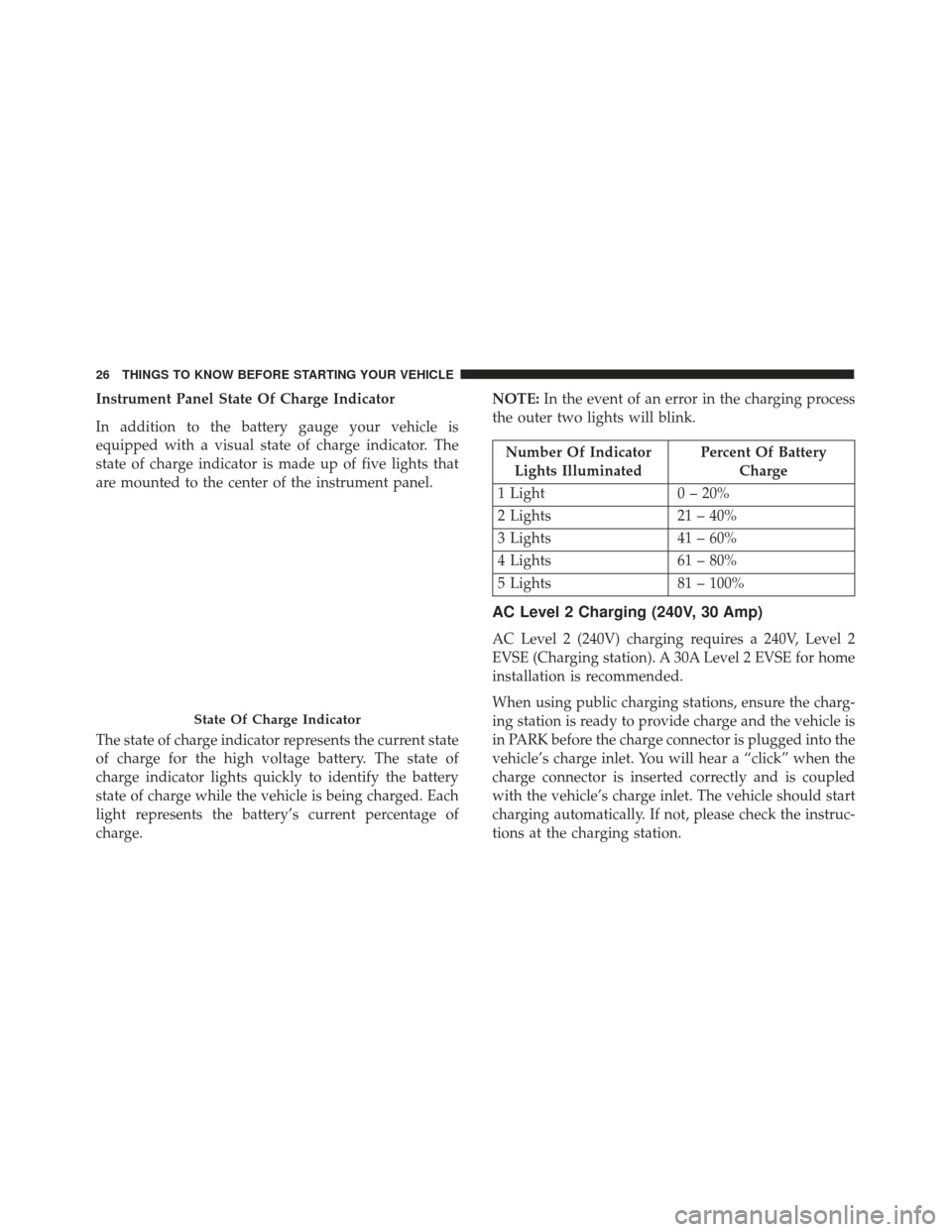
Instrument Panel State Of Charge Indicator
In addition to the battery gauge your vehicle is
equipped with a visual state of charge indicator. The
state of charge indicator is made up of five lights that
are mounted to the center of the instrument panel.
The state of charge indicator represents the current state
of charge for the high voltage battery. The state of
charge indicator lights quickly to identify the battery
state of charge while the vehicle is being charged. Each
light represents the battery’s current percentage of
charge.NOTE:
In the event of an error in the charging process
the outer two lights will blink.
Number Of Indicator Lights Illuminated Percent Of Battery
Charge
1 Light 0 – 20%
2 Lights 21 – 40%
3 Lights 41 – 60%
4 Lights 61 – 80%
5 Lights 81 – 100%
AC Level 2 Charging (240V, 30 Amp)
AC Level 2 (240V) charging requires a 240V, Level 2
EVSE (Charging station). A 30A Level 2 EVSE for home
installation is recommended.
When using public charging stations, ensure the charg-
ing station is ready to provide charge and the vehicle is
in PARK before the charge connector is plugged into the
vehicle’s charge inlet. You will hear a “click” when the
charge connector is inserted correctly and is coupled
with the vehicle’s charge inlet. The vehicle should start
charging automatically. If not, please check the instruc-
tions at the charging station.
State Of Charge Indicator
26 THINGS TO KNOW BEFORE STARTING YOUR VEHICLE
Page 29 of 300
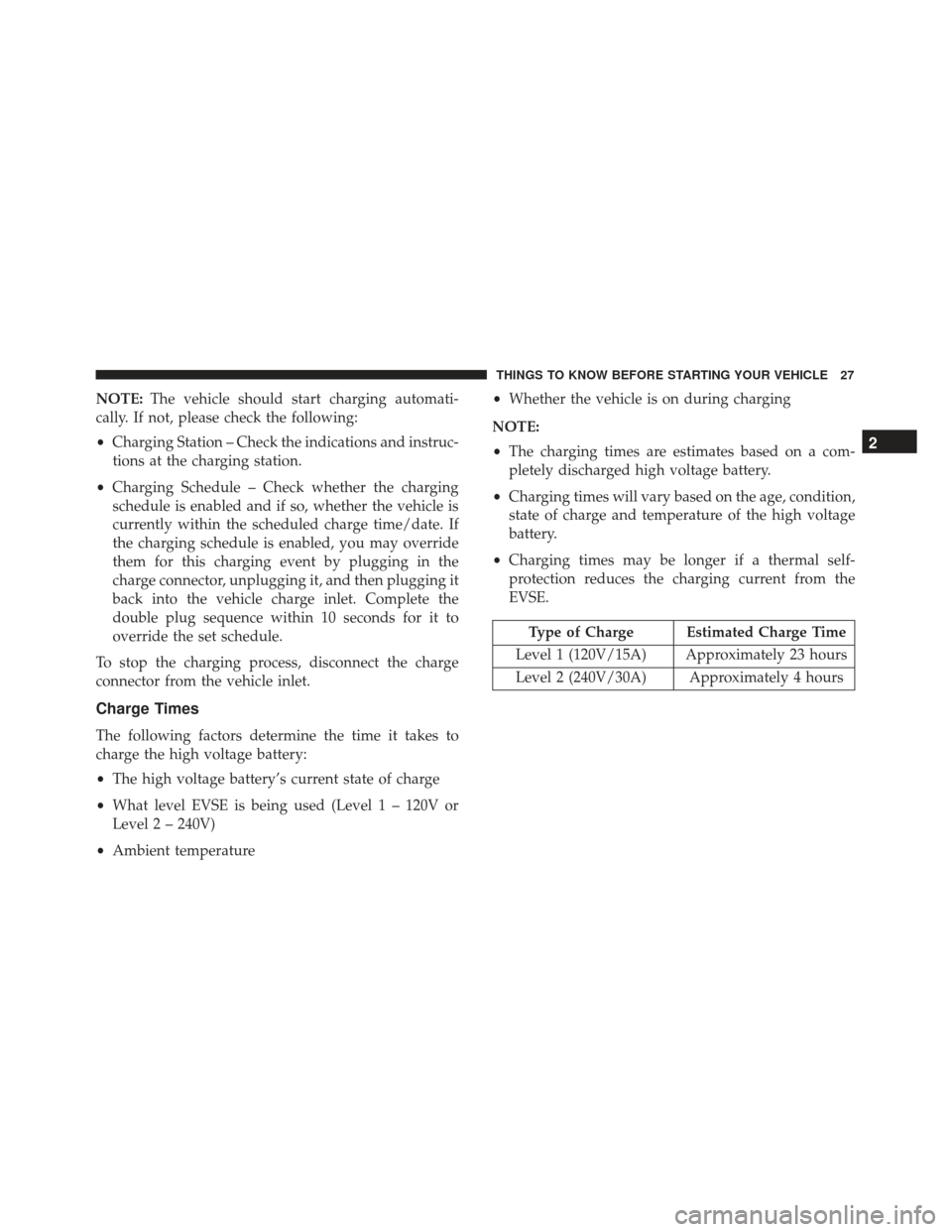
NOTE:The vehicle should start charging automati-
cally. If not, please check the following:
• Charging Station – Check the indications and instruc-
tions at the charging station.
• Charging Schedule – Check whether the charging
schedule is enabled and if so, whether the vehicle is
currently within the scheduled charge time/date. If
the charging schedule is enabled, you may override
them for this charging event by plugging in the
charge connector, unplugging it, and then plugging it
back into the vehicle charge inlet. Complete the
double plug sequence within 10 seconds for it to
override the set schedule.
To stop the charging process, disconnect the charge
connector from the vehicle inlet.
Charge Times
The following factors determine the time it takes to
charge the high voltage battery:
• The high voltage battery’s current state of charge
• What level EVSE is being used (Level 1 – 120V or
Level 2 – 240V)
• Ambient temperature •
Whether the vehicle is on during charging
NOTE:
• The charging times are estimates based on a com-
pletely discharged high voltage battery.
• Charging times will vary based on the age, condition,
state of charge and temperature of the high voltage
battery.
• Charging times may be longer if a thermal self-
protection reduces the charging current from the
EVSE.
Type of Charge Estimated Charge Time
Level 1 (120V/15A) Approximately 23 hours
Level 2 (240V/30A) Approximately 4 hours
2
THINGS TO KNOW BEFORE STARTING YOUR VEHICLE 27
Page 30 of 300

A WORD ABOUT YOUR KEYS
The key fob contains a mechanical integrated key. To
use the mechanical key, simply push the mechanical key
release button.
The vehicle is supplied with a code card containing key
code numbers to order duplicate keys, and the autho-
rized dealer that sold you your new vehicle has the key
code numbers for your vehicle locks. These numbers
can be used to order duplicate keys.
Ignition Key Removal
1. Place the transmission in PARK.
2. Rotate the key to the OFF/LOCK position.
3. Remove the key from the ignition switch lock cylin-der.
Mechanical Key Release Button
Ignition Switch Positions
1 — STOP (OFF/LOCK)
2 — MAR (ACC/ON/RUN)
3 — AVV (START)
28 THINGS TO KNOW BEFORE STARTING YOUR VEHICLE